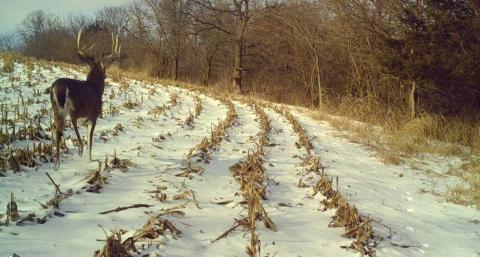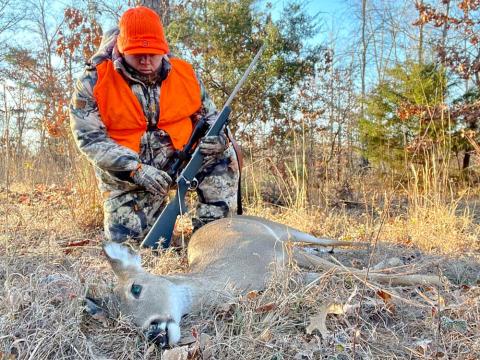Paul Annear
Terrain, thermals, back cover – there are a lot of factors you need to consider when deciding what height to hang your stand. Generally speaking, higher is better. This doesn’t mean a well-hidden hang-on stand tucked into a cedar tree eight feet off the ground won’t beat the eyes of a weary doe or mature buck, but in many situations you risk being spotted by a whitetail’s superior peripheral vision.
I was busted by countless deer while earning my stripes as a young hunter while hunting out of a thirteen-foot single ladder stand in the hill country of Wisconsin. After a few seasons, I realized I needed to be higher and be conscious of finding multi-trunk trees to hang stands nearby. Here is why tree stand height matters.
Is a Higher Tree Stand Better?

Drawing on a whitetail in archery range is the ultimate goal as hunters, and being higher in a tree generally accomplishes that goal. In most any terrain, unless the deer are even with you on the upslope of a hill, being higher gives you a better chance at beating a deer’s vision and getting away with more movement. Being higher doesn’t necessarily help with scent unless you are at such a height (probably unsafe) that a deer in close range won’t smell you.
When terrain is generally flat, I aim to hang my tree stands between 19-21 feet. I hunt mostly out of hang-on tree stands. For ladder stands, they are generally offered in 15-21 foot heights. Remember with ladder stands, you’ll need to angle the ladder against the tree, so you will lose a couple of feet in height. When archery hunting out of ladder stands, many of the ladders stick out far from the tree, leaving you exposed unless you can flip the seat up and stand tight against the tree. You can get creative and brush them in with burlap, but tucking them into cover or mult-trunk trees is your best bet.
Can You Get Away with Movement?
Like I mentioned in the previous section, beating a deer’s nose and vision is generally the most difficult task a hunter faces while a deer is within range. If the prevailing winds are heading right into a known deer bedding area or feeding location, being higher isn’t going to help. Winds will bend, deflect and make their way into the olfactory system of a whitetail regardless of tree stand height. A lot of the challenge becomes about vision when trying to get up close and personal with a whitetail in range.
Matching your camo pattern to the surrounding elements certainly plays a role in beating a whitetail’s vision, but back cover and height will ultimately win you the battle. Deer have larger eyes and pupils than a human and can gather about 18 times the amount of light that we can. This means they can see extremely well at night and will still catch subtle movements as shooting hours wane and big deer get on their feet.
However you need to get away with movement, that’s what you need to do. If it means the only good tree overlooking a food plot is the one leaving you exposed, face it the opposite direction of approaching deer and plan on standing for much of the hunt. If you can brush in a homemade ground blind with downed trees or logs – then do it. There are certain hunting situations where hunting from the ground will benefit you from a thermal and wind standpoint, but also help you get away with more movement.
While I’ve discovered I can get away with more movement by being higher, this doesn’t mean it’s the same for you. Don’t assume that you always need to be in a tree. Carefully brushing in a pop-up ground blind could be the ticket as well.
Consider the Terrain when Placing Tree Stand

If you hunt in hill country or deal with slight undulations of terrain, you know that tree stand height can make or break a hunt, especially when it comes to wary does with fawns. If deer will be even with you in height at any point of them getting close, you better have a multi-trunk tree or have great cover to conceal your presence.
I can’t remember the last time I was busted by a buck when hunting from a tree stand, but nearly every season I have at least one pesky doe that circles my perimeter like a special agent surrounding a suspicious scene. In my opinion, bucks are much easier to kill when they are in range, the trick is getting them into range! Playing the terrain can feel like cheating when it works, but can leave you scratching your head when thermals and light and variable winds play against you.
In hill country, if you set up 20-30 yards from where a ridge takes a steep drop, you can play the wind and have your breeze blowing into a no man’s land ditch or valley off the top of the ridge. Deer love to walk into the wind off the sides of ridges just below the peak crest. If you can set up just offset of this where deer have a wind quartering into them, you will give them a perception of safety.
When hunting river bottom terrain, it’s all about finding where the river bends and gives deer a crossing point for travel. Scout river bottoms in late winter to find last year’s trails. Unless major flooding changes the riverbanks, the trails will stay the same year after year and you can consistently count on movement through the same areas. Set up your stand about ten yards before the river crossing. Deer will preoccupied with preparing to cross, this will give you a chance to draw and mouth grunt to stop him before crossing.
Should You Hunt from a Saddle?
Hunting from a saddle is nothing new, but it’s become a trendy option when popular hunting figures began using them heavily in recent years. If you position your platform well and have other pegs to rest your feet on, hunting from a saddle can give you flexibility to swing around the tree and stay hidden behind the trunk from an approaching deer. Many saddle hunters will tell you the resting position while in a saddle can throw deer off and have them thinking you are a limb and not a hunter.
The truth is, any tree stand is a good option if you can get close to deer and not be seen. Trends in the hunting industry are just like any other fad or industry. Trends come and go. Just because a new car feels nicer and looks a little flashier doesn’t mean a vehicle with 200K miles won’t do the job. If you are efficient with your set up, stick with it and don’t look back. Remember, half the battle is won on the way to your tree stand. So if you’re quiet and efficient to your stand and while you’re hunting, why change?






























